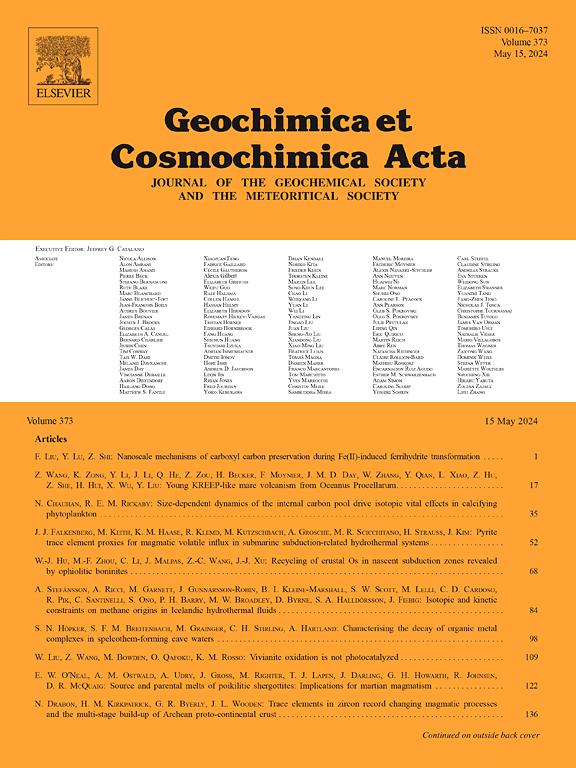镍铜硫化物矿床中的镍同位素变化:从理论预测到自然观测
IF 5
1区 地球科学
Q1 GEOCHEMISTRY & GEOPHYSICS
引用次数: 0
摘要
在全球含硫化物岩石中观测到极轻且变化很大的δ60/58Ni值,使Ni同位素成为岩浆硫化物矿床成因的潜在示踪剂。然而,导致硫化物中较大镍同位素变化的潜在机制仍不清楚。在本研究中,我们首先进行第一性原理计算,以确定60Ni/58Ni (60Ni/58Ni的103lnβ)对主要含镍硫化物矿物(包括黄铜矿、镍黄铁矿、黄铁矿和磁黄铁矿)的还原配分函数比。计算表明,黄铁矿和磁黄铁矿的60Ni/58Ni值的103lnβ值对Ni浓度敏感,硫化物的60Ni/58Ni值的103lnβ值在自然Ni丰度水平下以黄铜矿≈磁黄铁矿 <; 镍黄铁矿 <; 黄铁矿的顺序递增。然后,我们研究了不同类型岩浆镍铜硫化物矿床中硫化物矿物的镍同位素变化。尽管不同硫化物矿物之间存在显著的镍同位素差异,但磁黄铁矿和镍黄铁矿之间的同位素差异沿着理论计算的平衡同位素分馏线下降。随着Fe/(Fe + Cu)比值的降低,黄铜矿的轻Ni同位素逐渐富集,表明其Ni同位素组成随硫化物分馏在较宽温度范围内的变化而变化。图拉根(造山带背景)矿床中硫化物的镍同位素组成比葫芦岛(造山带背景)和金川(板内背景)矿床中的硫化物要轻得多。这些差异可能与形成这些矿床的不同矿化过程有关。图拉根矿床的母岩浆相对氧化,导致母岩浆熔体中大量同位素轻硫化物溶蚀,而葫芦岛和金川矿床的母岩浆在侵位前相对还原并分离出硫化物液体。我们的第一性原理计算和测量了岩浆硫化物矿床矿石样品中硫化物的Ni同位素组成,为未来将Ni同位素应用于这些具有重要经济意义的关键金属矿床的岩石成因评估提供了基础信息。本文章由计算机程序翻译,如有差异,请以英文原文为准。
Nickel isotopic variations in Ni–Cu sulfide deposits: from theoretical predictions to natural observations
Extremely light and highly variable δ60/58Ni values have been observed in sulfide-bearing rocks globally, making Ni isotopes a potential tracer for the genesis of magmatic sulfide deposits. However, the underlying mechanisms that cause the large Ni isotopic variation in sulfides remain unclear. In this study, we first conduct first-principles calculations to determine the reduced partition function ratios of 60Ni/58Ni (103lnβ of 60Ni/58Ni) for major Ni-doped sulfide minerals, including chalcopyrite, pentlandite, pyrite, and pyrrhotite. Our calculations demonstrate that the 103lnβ of 60Ni/58Ni values of pyrite and pyrrhotite are sensitive to Ni concentration, and the 103lnβ of 60Ni/58Ni values of sulfides increase in the order chalcopyrite ≈ pyrrhotite < pentlandite < pyrite at natural Ni abundance levels. We then investigate the Ni isotopic variability of sulfide minerals from different types of magmatic Ni–Cu sulfide deposits. Despite the significant Ni isotopic variability observed among the different sulfide minerals, the isotopic differences between pyrrhotite and pentlandite fall along the theoretically calculated equilibrium isotope fractionation line. Chalcopyrite exhibits a progressive enrichment in light Ni isotopes as its Fe/(Fe + Cu) ratio decreases, suggesting that its Ni isotopic composition varies with sulfide liquid fractionation over a wide range of temperatures. Sulfides in the Tulaergen deposit (orogenic setting) have systematically lighter Ni isotopic compositions compared to sulfides in the Hulu (orogenic setting) and Jinchuan (intraplate setting) deposits. These differences may be associated with the different mineralizing processes that operated to form these deposits. The parental magma to the Tulaergen deposit was relatively oxidized, leading to the dissolution of a large amount of isotopically light sulfides in the source of the parent melts, whereas the parental magmas to the Hulu and Jinchuan deposits were comparatively reduced and segregated sulfide liquid prior to emplacement in the crust. Our first-principles calculations and measured Ni isotopic compositions of sulfides in ore samples from magmatic sulfide deposits provide foundational information for the future application of Ni isotopes to the petrogenetic assessment of these economically significant critical metal deposits.
求助全文
通过发布文献求助,成功后即可免费获取论文全文。
去求助
来源期刊

Geochimica et Cosmochimica Acta
地学-地球化学与地球物理
CiteScore
9.60
自引率
14.00%
发文量
437
审稿时长
6 months
期刊介绍:
Geochimica et Cosmochimica Acta publishes research papers in a wide range of subjects in terrestrial geochemistry, meteoritics, and planetary geochemistry. The scope of the journal includes:
1). Physical chemistry of gases, aqueous solutions, glasses, and crystalline solids
2). Igneous and metamorphic petrology
3). Chemical processes in the atmosphere, hydrosphere, biosphere, and lithosphere of the Earth
4). Organic geochemistry
5). Isotope geochemistry
6). Meteoritics and meteorite impacts
7). Lunar science; and
8). Planetary geochemistry.
 求助内容:
求助内容: 应助结果提醒方式:
应助结果提醒方式:


